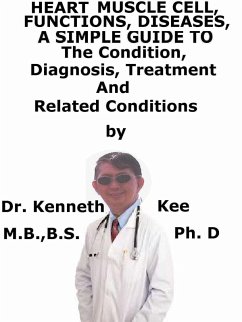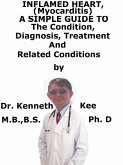The heart is the core of the cardiovascular system.
It is a muscular pump of interconnected, branching muscle fibers sited between the lungs with two-thirds of the region to the left of the midline of the body.
It is enveloped by a white fibrous sac called the pericardium which has 2 layers between which is a lubricating fluid permitting the movement of the heart as it contracts and expands.
The inner lining of the sac acts as the outer lining of the heart and is termed the epicardium.
The heart wall has a middle layer termed the myocardium which comprises thick bands of involuntary striated muscular tissue accountable for the heart to pump blood.
A third layer termed the endocardium is a thin layer of flat cells lining the heart valves and the inner cavities of the heart.
The human heart has 4 chambers which are the 2 superior atria and 2 inferior ventricles.
The atria are the reception chambers and the ventricles are the discharge chambers
Deoxygenated blood moves through the heart in one direction, entering through the superior vena cava into the right atrium and is pumped through the tricuspid valve into the right ventricle before being propelled out through the pulmonary valve to the pulmonary arteries into the lungs.
The oxygen is taken in from the air sacs of the lungs.
It enters from the lungs through the pulmonary veins to the left atrium where it is pumped through the mitral valve into the left ventricle before exiting through the aortic valve to the aorta
The heart beat comprises the alternate contractions and relaxations of the atria and ventricles.
The heart beat can be heard in a stethoscope as 2 sounds "lub-dub", the first resulting from the closure of the mitral and tricuspid valves and contraction of the ventricles, the second shorter and snapping sound resulting from the closure of the aortic and pulmonary valves.
The pumping action of the heart is one of contraction or systole and relaxation or diastole.
This is accompanied by a brief rest period.
The rhythm necessitates a balance of calcium, sodium and potassium in the heart muscle.
A normal resting heart rate for adult varies from 60 to 100 beats a minute.
Life and death of a heart muscle cell
My name is Heart Man the cardiac muscle cell.
I was born in the body from a stem cell during the development of the embryo.
During development, myoblasts (the muscle progenitor cells) either remain in the somite to form muscles linked with the vertebral column or migrate out into the body to form all other muscles.
The myoblasts migrate to the heart to form myocardial cells.
We heart cells contain myofibrils which are long chains of sarcomeres the contractile units of muscle cells.
The arrangement of actin and myosin is similar to skeletal striated muscle.
Most of us are Y shaped and are shorter and wider than skeletal muscle cells.
The branching of the our cells help us to communicate with our fellow heart cells easily
Unlike multinucleated skeletal cells, we only have only one or two nuclei.
We also have a high mitochondrial density allowing us to produce ATP quickly making us highly resistant to fatigue
There are 2 types of cells within the heart:
Myocardiocytes
Cardiac pacemaker cells.
We myocardiocytes make up the atria and ventricles
My co-worker Pacermaker Cell carries the impulses responsible for the beating of the heart
Intercalated disks are located between our cardiac muscles cells synchronizing muscle contraction
The heart beats nonstop about 100,000 times every day
I, the cardiac muscle, am nearly completely reliant on oxygen to function
Without oxygen we will die.
TABLE OF CONTENT
Introduction
Chapter 1 Heart
Chapter 2 Functions
Chapter 3 Life Cycle
Chapter 4 Diseases
Chapte...
Dieser Download kann aus rechtlichen Gründen nur mit Rechnungsadresse in A, B, CY, CZ, D, DK, EW, E, FIN, F, GR, H, IRL, I, LT, L, LR, M, NL, PL, P, R, S, SLO, SK ausgeliefert werden.









